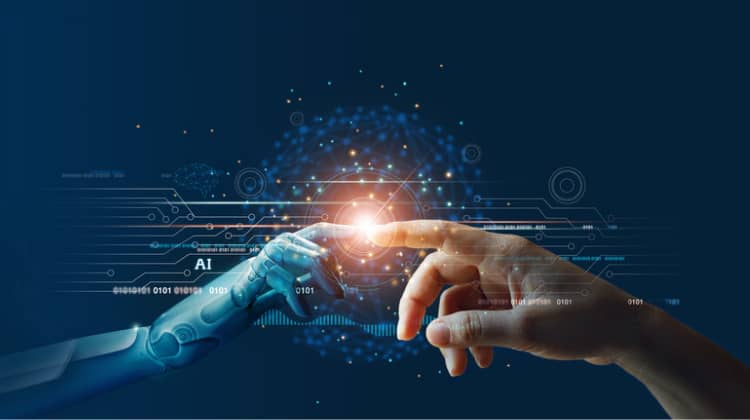Artificial intelligence (AI) promises huge advantages for smart data processing and automation, potentially affecting every area of our daily lives and influencing the planning and implementation of smart city projects across all six fields of action; however, the creation of AI also poses some important questions. If we relinquish the administrative control of certain processes and services to AI, how can we ensure that they will be inclusive? What will the future labor market look like, and what implications will machine intelligence have for education? Policymakers in particular need to keep ahead of the curve and form a standard legal framework in order for cities to make the most of what AI has to offer.

What Benefits Can Artificial Intelligence Offer a Smart City?
A key enabling step in making a city smarter is to improve its connectivity. The accessibility of its data and the speed of its networks, including its Internet of Things (IoT), directly inform what the city has to offer its stakeholders. Taking advantage of the network effect – the concept that, as platforms get bigger, they get smarter – artificial intelligence refers to the potential for code to learn, to remember our preferences so that it can begin to make certain decisions for us, to take over complex operations and processes on our behalf. In its simplest form, it represents data processing at a volume, speed, and accuracy not currently possible.
In the context of smart cities, adopting machine learning models for operational decisions makes a lot of sense. One major potential benefit of AI for smart cities is the low-cost, custom manufacturing of any kind of product, exactly when and where it’s needed (generally referred to as Industry 4.0). Already, automated manufacturing reduces labor costs, making local production increasingly economical and reversing the trend to send it ‘offshore’ (outsourcing it to another location, usually international, where labor is cheaper). This is expected to continue as Industry 4.0 – a combination of robotics and intelligent, teachable software – is more widely adopted. The concept of manufacturing will change completely since flexibility will trump scale as the key to the future of production. This is predicted to boost economic growth by increasing productivity, something which is already being observed in the retail and aerospace industries: robotics has been combined with machine learning for the preparation of shipments for Amazon and for the simplified manufacture of 3D-printed jet engine parts.
Another area where AI is set to make waves is healthcare. With superior data processing capabilities, it is clear how machine learning could benefit diagnostics, helping to get results to patients faster by pre-screening them and only requiring the input of a trained physician where a clear negative cannot be asserted. Anything that speeds up the process of drug discovery significantly reduces research and development costs, lowering a drug’s final price tag and making the production of drugs for problems prevalent only in poorer countries more economically attractive for pharmaceutical companies. These same benefits should also bring the promise of personalized medicine much closer.
One company poised to take advantage of these possibilities is iCarbonX, established in China in 2015 and funded by a combination of biotech, electronics, and internet-innovation investors. Already listed as one of Fortune magazine’s top 50 companies “leading the AI revolution”, iCarbonX boasts an ability to measure the human adaptive immune response at scale and has publicly presented its digital health management platform (Meum), which its founder Jun Wang ambitiously claims will digitize, analyze, and understand life. To the end-user, Meum is a sort of personal guide, not only able to assess health and fitness but also to predict health outcomes and offer advice. It allows access to apps that will monitor and track fitness, skincare, and nutrition, but is also open to developers and researchers.
Artificial Intelligence in Action
Beyond healthcare and manufacturing, investors are currently developing AI for online retail and networking, chatbots such as the city of Vienna’s WienBot, and sophisticated traffic control systems, as well as the simulation of new mobility solutions.
Many recent AI headlines have concerned its implementation for autonomous vehicles (AVs), which are being developed as a safer and logistically smarter alternative to fallible human drivers and which may serve to replace private vehicle traffic in the distant future. BMW and Intel, for example, have joined forces toward the production of levels 3 to 5 AVs by as soon as 2021 (see SAE definitions), and plans from Ford and its academic partners at the University of Michigan are no less ambitious. But putting AI at the wheel will require it to make many decisions which, mundane as they may seem, will have significant safety implications – decisions which could literally mean life or death for its passengers or for pedestrians. There will also inevitably be situations where AI must weigh the value of a life and choose between two negative outcomes. That kind of decision is hard enough for a human being – how and when should a machine discriminate?
The Morality of Artificial Intelligence
The training of AI, just like the rearing of a child, is where the challenges become clear. As assessed in a survey of over 2 million people worldwide (the Moral Machine), moral judgments differ between individuals and across cultures – but the ideal algorithm must be able to serve universally. A related challenge is the need to develop AI that is free of undesired bias but, as an algorithm is fed data, it absorbs any biases present and adopts them as its own. These could be dangerous lessons: in applications regarding public safety, AI-driven facial recognition software can track a person down within ten minutes based on CCTV surveillance of a city, and smart glasses being worn by police officers in China can help to quickly identify suspects; however, this software is being adapted to go beyond an individual’s identification and to engage in predictions of potential criminal behavior, and unfortunate examples of racial bias have been observed. In general, the ability to identify a stranger in need can be beneficial, but also raises privacy concerns.
Many other decisions already made at least partially by AI can directly affect the course of a person’s life, such as questions of employment or whether or not funding or insurance applications are accepted. Using AI can be a way to avoid any unrecognized personal biases affecting such decisions – but not if we pass them on.
Inclusivity is a problem in more ways than one. While AI is making decisions behind the scenes for all of us, the number of people capable of developing it (directly affecting how it is developed and applied) is limited. Governments worldwide have created special programs, networks and even hands-on opportunities to support the digital education of their citizens, usually geared toward making better use of open data and encouraging innovation to find smart solutions to their problems. It is plausible that the average, motivated citizen can learn to generate basic apps or develop prototype solutions when provided the right technology and support, but even with companies like the non-profit OpenAI offering public access to AI information and Google and Microsoft providing access to AI tools, the level of technical knowledge required to work with all this leaves most people behind. This places an enormous responsibility on those developing AI for the benefit of the whole community. In short, the real-world application of AI without unwanted biases all comes down to its training, which is currently in the hands of a few “centers of innovation”.
Training and Applying Artificial Intelligence
Moral questions aside, the real world is messy: it doesn’t follow neat rules, and people don’t always make rational or predictable decisions. That can be very difficult for AI to emulate, especially without the sort of instant recognition of a word or concept and its easy translation from one context to another that even small children take for granted. The usefulness of an AI model in the real world will therefore depend strongly on the quality and breadth of its training, which is dependent on the datasets it is given to study.
It is down to the perceived value of AI, both to society as a whole and also in financial terms, that entire companies are dedicated to the development and training of AI models. One such example is the San Francisco-based platform Figure Eight, which trains and tests ‘human-in-the-loop’ (HTL) machine learning models (those which require some form of human interaction). Figure Eight develops labeled sets of data suitable for the proper training of a model. These labels are crucial to the way a machine interprets the data it is being given. The range of data types this company works with – text, images, product information, audio and video – reflects AI’s broad potential, and many well-recognized brands such as eBay, Adobe, and Spotify have enlisted their services.
Carefully trained AI promises to be equally beneficial for all. With a view to ensuring this, the European Union has commissioned a set of ethical guidelines governing its development and use within Europe. The aim of these guidelines is also to boost public and private investment in AI, and to help governments prepare for the socio-economic changes expected to come from its application – changes which are only partially clear.
The Impact of Artificial Intelligence
The adoption of systems that are able to grow smarter over time is predicted to push the labor market further toward a highly digitally and technically skilled workforce, better connected to share local expertise across multiple stakeholders and with smarter supply chains to feed a flexible, on-demand industry. This is already the goal of most smart cities looking to transition to an innovation-based economy.
At least in the short term, this shift represents a big risk to employment and equality, both of which strongly affect the economy and the ‘heart’ of an inclusive city: as jobs are replaced through automation, those investing in its enablers will end up on one side of a line while those being displaced by it will find themselves on the other. How easily this issue is mitigated will be down to the speed and handling of the transformation, necessitating strong, clear governance and forward-thinking policies.
There’s still a big wait-and-see factor, with some experts deliriously optimistic and others predicting mankind’s doom as the machines take over our lives – though similar things have been said of now-ubiquitous smartphones with intelligent digital assistants.
Become a member of the global smart city network and community to discuss AI in smart cities and solutions with thousands of smart city experts worldwide. Find AI-powered solutions or share your own insights and solutions. Join today!
Read related articles:
- The Use of AI for Smart Urban Services in Smart Cities
- Building Smarter: Smart Technologies for Design and Construction
- How Can Smart Cities Improve Urban Public Health
- Read more Smart City Strategy articles
Image Sources:
iStock: ID: 1071576628, Credit: NegMarDesign
iStock: ID: 1206796363, Credit: ipopba


